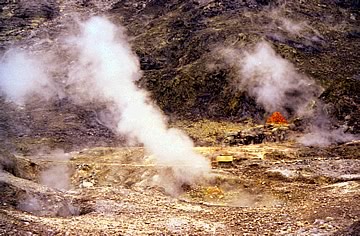

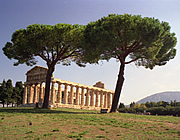
Staying near the famous temple complex of Paestum, we explored Pompeii, took on the crazy drivers on the Amalfi Coast and visited the sulphurous vents of the Phlegrean Fields.

The Doric temples at Paestum are famous, but perhaps not so well-visited as the more traditional tourist venues in Southern Italy such as Pompeii and Naples. We stayed in the converted stable block of an ancient palazzo on the outskirts of the "new" town, south east of Salerno, and were able to drive to the archaeological site in about ten minutes.
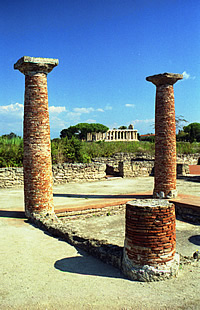
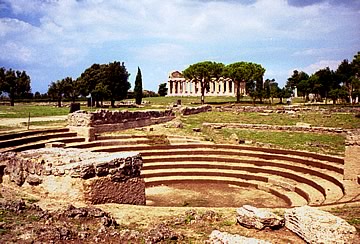
The small shops opposite the entrance to the site sell guide books, although the only English guide book we could find looked to be about as old as the site itself! There is also a decent pizza place here but pizzas were not available at lunch time due to the time it takes to fire up the traditional ovens!! There is no shop inside the site which makes a pleasant change.
Greeks from Sybaris founded a city here in the 6th century B.C. and named it Poseidonia in honour of the god of the sea. The city was invaded in about 400 B.C. and overwhelmed by the Lucanians - an Italic people of the mountains - who renamed it Paiston or Paistos. Briefly retaken by Alexander's nephew in 332 B.C. the Lucanians were finally defeated by the Romans in 273 B.C.
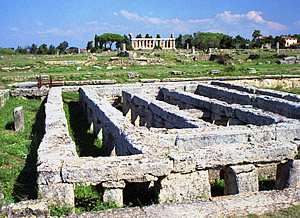
The Roman colony at the newly named Paestum was a faithful to Roman outpost, supplying ships and sailors in times of need. Trade prospered but the population was decimated by malaria caused by the silting up of the river Salso south of the settlement. In the 9th century the much reduced population retreated to the mountains, perhaps finally driven out by Saracen raids. The city was left to decay until it was rediscovered in the eighteenth century. Paestum saw a further invasion in 1943 when the American Army passed through following the British-American landings at Salerno.
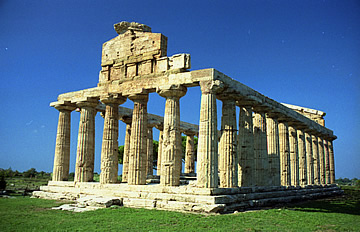
We entered (L8000) at the north end, close to the smallest of the three magnificent temples - the Temple of Ceres (also known as Athena). Built around the end of the sixth century B.C. this beautiful golden stone temple is the smallest of the three on the site. As with all three temples, the altar is placed outside and to the east of the main building.
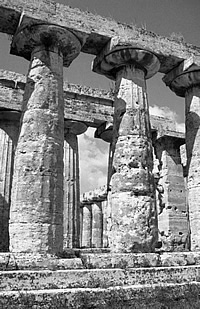
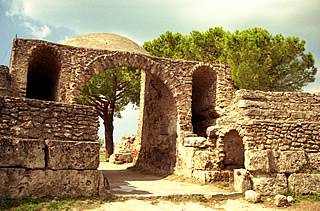
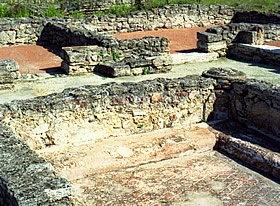
Between it and the two larger temples lie the remains of the Roman town - low foundations and walls for the most part but still indicative of a bustling city with an amphitheatre, Forum, shops and houses. The Sacred Way begins at the southern Porta Giustizia and runs northwards; at the Forum it crosses the decumanus maximus - the main east-west road passing through the Porta Marina to the west and the Porta Sirena to the east. It runs west of the two greatest temples - the Temple of Neptune lying north of the Temple of Hera.
The Temple of Neptune (Neptune was the Roman name for the Greek god Poseidon), the largest of the three temples, dates from around 450 B.C. and is remarkably complete, being composed of fluted Doric columns, 6 on the east and west faces with pediments, 14 to each long side. Inside there is a columned porch at each end between which is the cella - the true residence of the divinity and, therefore, the most sacred part of the temple - within a double row of seven columns. Unfortunately the temple was shrouded in scaffolding and netting when we visited and though the temple columns could be seen through the netting it didn't make for a great photograph! This temple, the largest intact Doric temple in Italy, is magnificent and very well preserved..
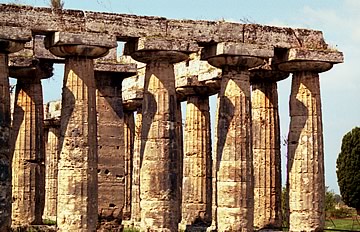

The Basilica or Temple of Hera (also partly obscured by scaffolding) is the oldest temple, built around the middle of the sixth century B.C., and originally called the Basilica because the first archaeologists mistook it for a civic building. It has nine columns on the east and west fronts, and eighteen along the sides. Inside, as in the Temple of Neptune, is a cella.
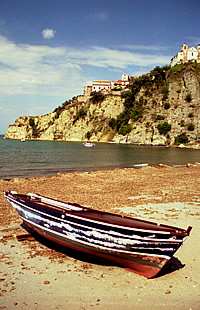
South of Paestum Agropoli is a little older than Paestum, also founded by the Greeks, though withut the spectacular ruins. In September it didn't have a great deal to offer apart from the picturesque harbour and the old town perched on a promontory. This part of Italy seems to close down after the summer, the beaches are deserted - and can be dirty- and it can be quite difficult to find somewhere to eat. We found one very good restaurant in Agropoli, open on a Sunday and full of Italian families eating a leisurely lunch.
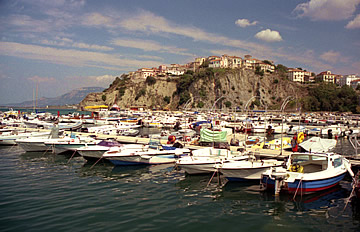
In the Zona Archeologica the best meal we had was lunch at the Ristorante Nettuno (not open evenings at this time). This was also the most expensive meal we had but at L94000 the three courses and excellent bottle of wine were well worth it (approx L2500 to £1 at this time!) We also enjoyed a meal at the Hotel Helios where, when we declined to try the traditional starter of three largeish balls of mozarella on the grounds that it would be too filling, they insisted on bringing it to us free - and it was, of course, excellent. This is an area specialising in authentic mozarrella made from the milk of the buffalo which can be seen grazing around the countryside. The Hotel Ariston American Bar is well worth searching out for pre-dinner drinks and, also in nearby Laura, da Nonna Sceppa served good pizzas.

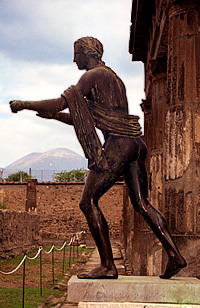
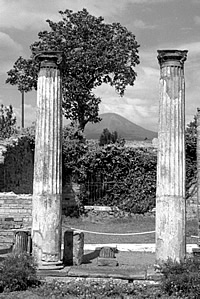
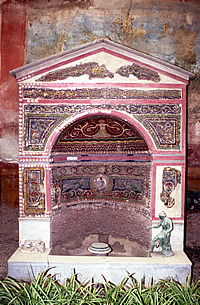
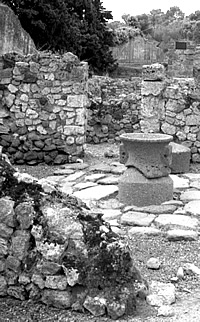
The story of the eruption of Vesuvius in 79 A.D.which buried the town of Pompeii, preserving the scene for later archaeologists, is well-known. It is possibly less well-known that the volcano had been showing signs of increased activity for some days before the final eruption, and that most of the town's 20,000 inhabitants had already left.
Many did perish, however, and some of the most poignant remains are the casts taken of the cavities left after the bodies, buried by the ash and pumice, had decayed away.
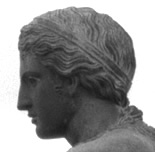
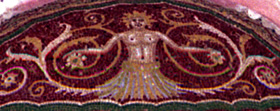
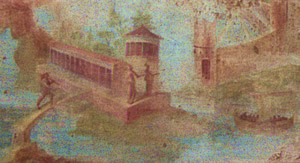
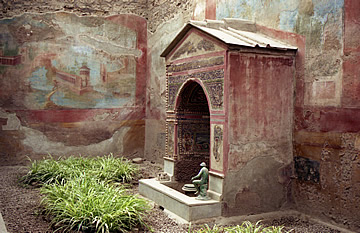
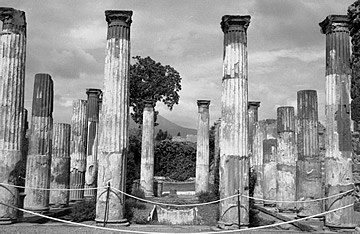

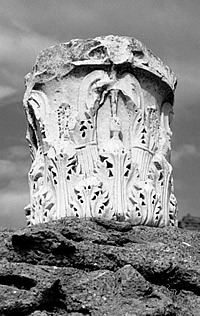
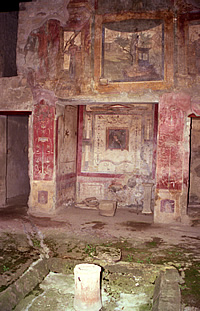
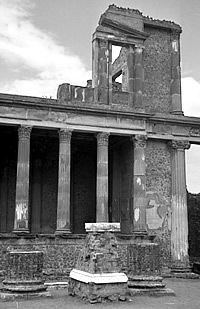
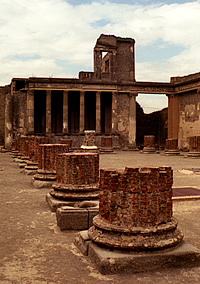
Many frescoes remain intact, and the ancient ways come to life on the walls of the villas. One of the best is the Villa dei Misteri, at the far end of the Street of Tombs. This villa is large, with complete rooms, many with wonderful wall-paintings, and it is the sequence of fine paintings on the walls of the dining room which give the villa its name.
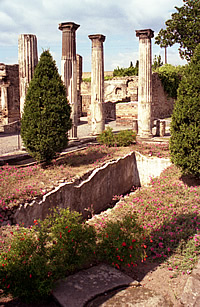
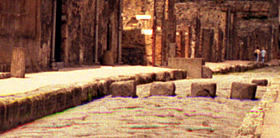 Stepping stones to
avoid
the muck in the road!
Stepping stones to
avoid
the muck in the road!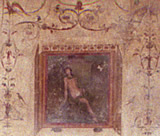
Today the town (entry L.12000) is a marvellous evocation of the life of Romans 2000 years ago. Monumental buildings such as the basilica, temples and civic halls and offices stand around the Forum - the centre of the city. Spreading out from here are the houses and shops which make up most of the streets; there are public baths, more temples and, on the eastern outskirts, the theatres and amphitheatre where the games were held.
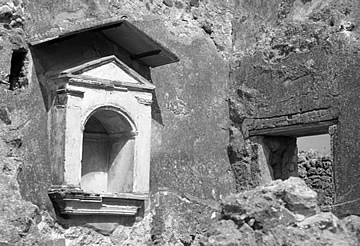
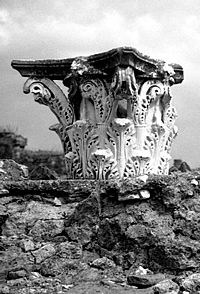
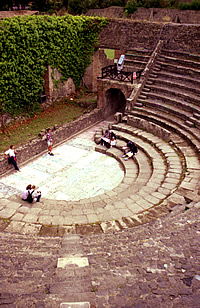
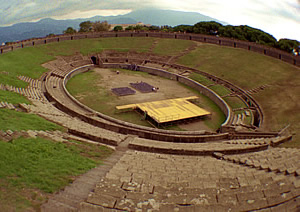
The Basilica on the edge of the Forum is one of the very earliest known, having been built towards the end of the second century AD. A Roman Basilica is a public building used for business and lega matters, maybe a covered market.
We managed to see the major parts of the site in one day but two would be better. It was hot and quite oppressive and we got very tired, especially as lunch time found us nowhere near the only restaurant on the site and returning to it involved visiting several villas, etc in the interests of efficiency! Of many highlights I particularly liked the Via dell'Abbondanza with its two-storeyed buildings and the many shops of a type called thermopolium which sold hot food from huge pots set in counters.
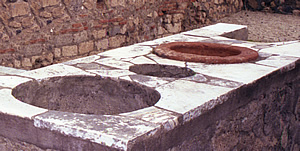
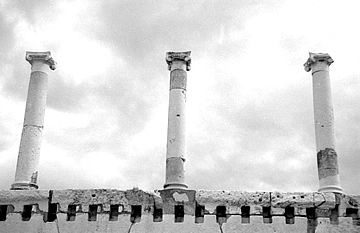
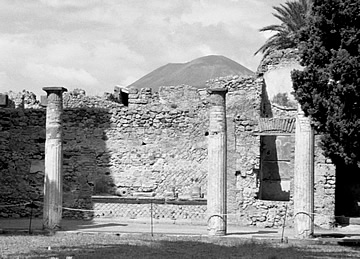
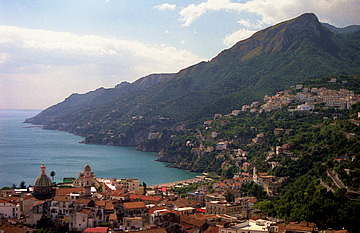
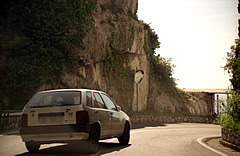
It was quite an experience driving these roads - overtaking on blind bends obligatory and sheer bravado a must - the road sign "Give way to overtaking traffic" says it all! The roads are so narrow that in many places you can expect to be pulled in to the side of the road for as long as it takes the local bus/delivery wagon/truck to make the slow ascent to Ravello or wherever. Heaven knows what it's like at the height of summer!
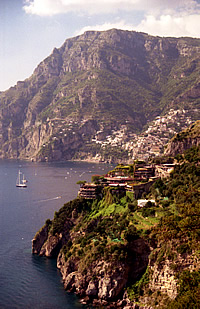
The views of the coast are stunning. We drove along the southern coast, making a detour up a great switchback road to Positano, and then along to the western end and up over the top to Sorrento.
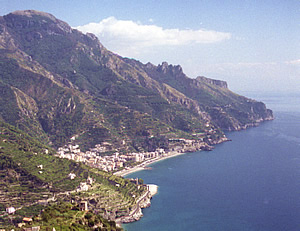
Where the road zig-zags up over the end of the peninsula both the north and south coasts can be see - pretty spectacular! Then rather tired we headed back north east to complete the route.
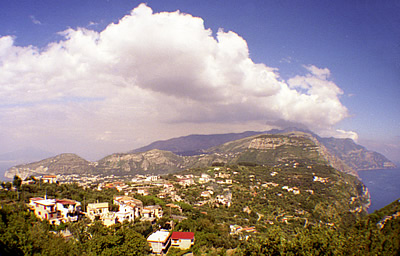
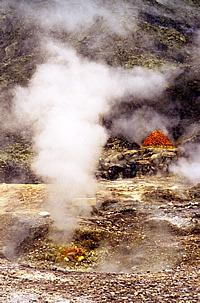
A long drive but worth it - this place is like nothing I had ever seen - or smelt outside a school chemistry lab!
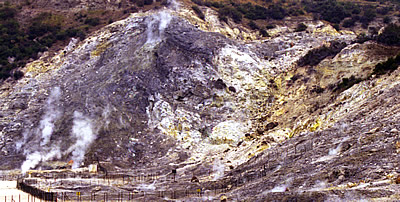
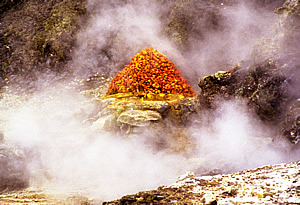
The Solfatara di Pozzuoli (entry L.8000) are part of the wider volcanic area known as the Phlegrean Fields. The ground alternates between bubbling, boiling mud and scorching rocks. This is an "inactive" volcanic crater, from which escape sulphurous plumes of vapour - the fumaroles; at covered vents rumblings can be heard from deep underground.
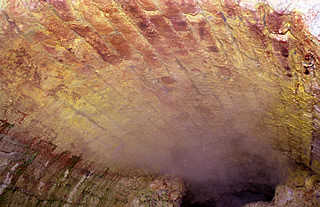
A yellow landscape and an atmosphere that stinks make this a fitting site for the Ancient Roman Gateway to Hell - less obviously the site of the Elysian Fields!
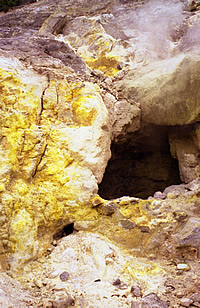
Beautiful sulphur crystals form all over the site, the most accessible examples being in the entrances to the two formations known as "Hell" and "Purgatory" - if you can stand to get into such a confined space.
These brick tunnels were also used as natural saunas and the whole area had some reputation as a spa for its mineral waters and boiling mud rheumatic cures.
